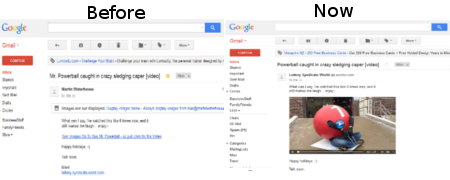Starting today Gmail emails will now show images by default.
This applies to all emails — not just trusted senders, particular mailboxes or those for whom you’ve already clicked ‘Always display images from’.
So inboxes are about to become a whole lot more colourful.

How Can They Make Such A Radical Change?
Well firstly, users can turn this setting ‘off’ again, to get the same ‘per message’ behaviour as before.
But mainly because as Google said in their announcement, they are actually using their own secure proxy servers to deliver the images to the end mail user. Which also means they are filtering for viruses and malware.
What About Privacy & Tracking?
What’s not quite so clear is how privacy and tracking works with the image display.
Will they automatically display those 1 by 1 pixel tracking images used to determine email open rates? If so, proxy use will not prevent tracking working. And indeed Aweber seem confident that this is the case:-
Since opens are recorded when images display, you’ll now be able to see opens from Gmail subscribers who weren’t previously loading your images.
The proxy server use would prevent any IP based tracking (or privacy issues) with images served from a fixed URL, as all images would show as being requested by Google.
Tracking pixels however use custom URL’s unique to each recipient to determine which user opened which email. So whilst they would appear to be requested by Google, they in theory will still reliably track when recipients open the email.
What About Caching?
But what’s also not clear yet, is if Google is (or will in future) cache email images.
It would be trivial for Google to determine an image is identical across 10,000 Gmail recipients, all with the same sender. And then simply request that image once and serve up a local cached copy for the other 9,999 recipients.
Which would lighten server load for email senders just a little if each Gmail image is now served by Google instead of requested each time from the senders server.
But caching, in theory, wouldn’t impact tracking as each 1 x 1 pixel image, on a unique URL, still needs to be requested to be sure it is (or isn’t) the same as all the other 1 x 1 pixel images.
Of course it would also be trivial for Google to simply to not display all 1 x 1 images on unique URL’s too…